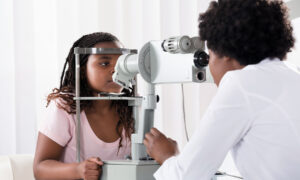June 3, 2019
By Dwight Akerman, OD, MBA, FAAO
Chief Medical Editor, Review of Myopia Management
Orthokeratology is an increasingly popular method for reducing the progression of myopia in children and teenagers. Eye care professionals report that overnight orthokeratology (OOK) provides appropriate patients with a “wow” factor by eliminating the need to wear contact lenses or eyeglasses during the day. Practitioners also anecdotally report that children and teenagers with mild dry eye symptoms often are less symptomatic while being treated with OOK lenses compared to daily wear multifocal soft contact lenses for myopia management.
Researchers conducted a prospective study to investigate the effects of OOK lens on the ocular surface and meibomian gland over a wearing period of two years in myopic children and teenagers from 7 to 18 years of age.
Compared with the baseline values, Ocular Surface Disease Index (OSDI) scores for ocular discomfort increased with the wearing of OOK and peaked at the 6-month visit. OSDI scores began to decline at 12 and 24 months after wearing OOK and had no significant difference with the baseline values. This regression of OSDI scores may relate to the adaption of overnight lens wear.
The researchers concluded that overnight orthokeratology increased the symptoms of dry eye and decreased the function of the tear film by affecting the meniscus height and BUT. However, overnight orthokeratology did not affect the function of meibomian glands.
Abstract
The Influence of Overnight Orthokeratology on Ocular Surface and Meibomian Gland Dysfunction in Teenagers with Myopia.
Wang X, Li J, Zhang R, Li N, Pang Y, Zhang Y, Wei R
Purpose: The aim of this study was to investigate the effect of overnight orthokeratology (OOK) on ocular surface and meibomian gland dysfunction in teenagers with myopia.
Methods: A total of 59 subjects were recruited in this prospective study. The following tests were performed before and after 1, 3, 6, 12, and 24 months of OOK lens wear, including ocular surface disease index (OSDI) questionnaire, slit-lamp examination, and Keratograph 5M.
Results: No infectious keratitis occurred during the study. OSDI scores increased gradually and reached the maximum at 6 months of OOK wear (P < 0.001). The meniscus height was significantly increased at 1 and 3 months after the initiation of OOK (P=0.006, P=0.035). The corneal fluorescein staining at 1, 3, 6, 12, and 24 months after wearing OOK were all increased than the prewearing level with significant difference (P=0.014, P=0.036, P < 0.001, P < 0.001, and P=0.008, respectively). The first and the average tear film NIKBUT were all higher than the prewearing level, but there was no significant difference between every follow-up time points (P > 0.05). The lid margin abnormalities were significantly increased (P=0.003, P=0.038, and P=0.015) at 6, 12, and 24 months after the initiation of OOK. There was no significant difference in the meibomian gland orifice scores at each follow-up time points compared to the prewearing level (P > 0.05). The meibomian gland lipid secretion scores after wearing OOK were higher than those of the prewearing level, however, without statistically significant difference (P > 0.05). No significant differences of the degree of difficulty of lipid excretions were detected after the initiation of OOK (P > 0.05). There was no significant difference in meibomian gland dropout scores between all follow-up time points and the prewearing level (P=1.000).
Conclusion: OOK increased the symptoms of dry eye and decreased the function of tear film by affecting the meniscus height and BUT. OOK did not affect the function of meibomian glands.
Wang, X., Li, J., Zhang, R., Li, N., Pang, Y., Zhang, Y., & Wei, R. (2019). The Influence of Overnight Orthokeratology on Ocular Surface and Meibomian Gland Dysfunction in Teenagers with Myopia. Journal of ophthalmology, 2019.











